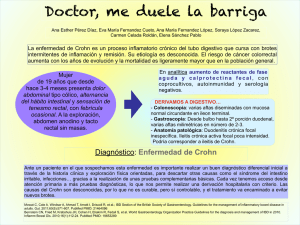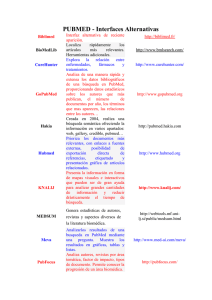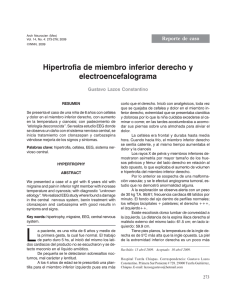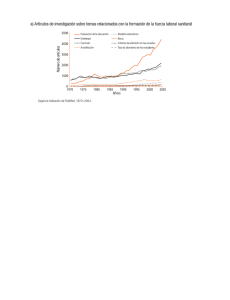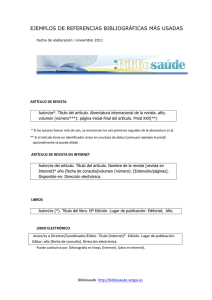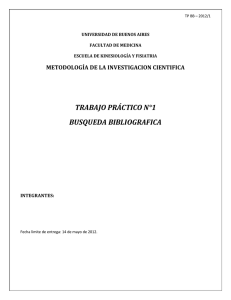análisis biomecánico de la postura, marcha y carrera
Anuncio
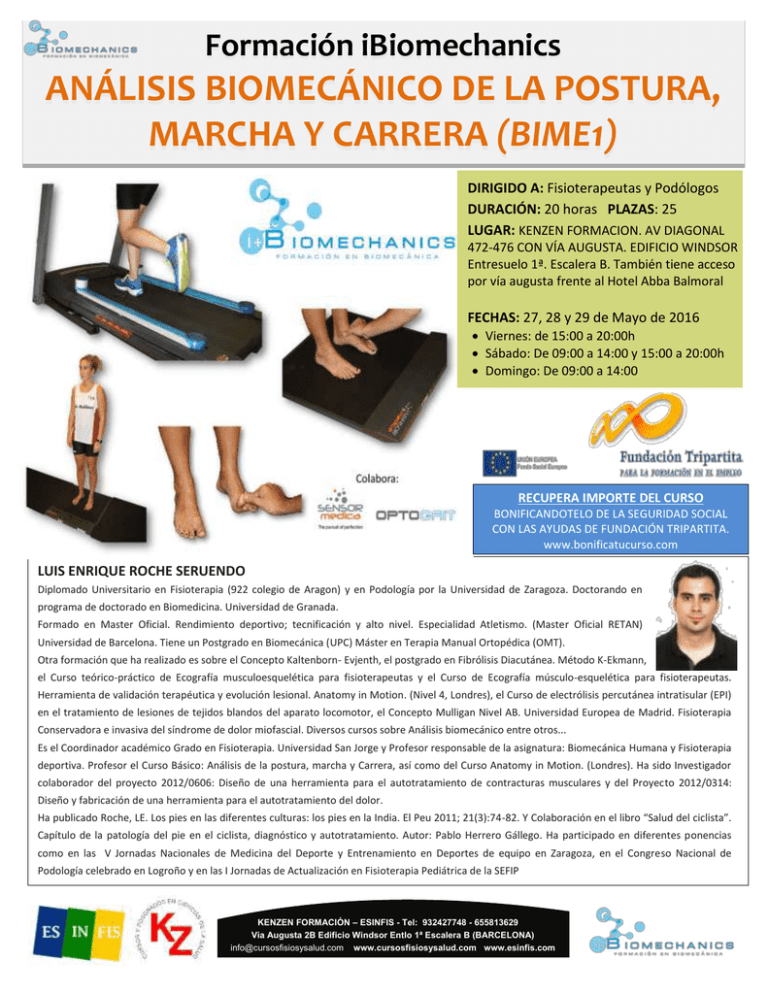
Formación iBiomechanics ANÁLISIS BIOMECÁNICO DE LA POSTURA, MARCHA Y CARRERA (BIME1) DIRIGIDO A: Fisioterapeutas y Podólogos DURACIÓN: 20 horas PLAZAS: 25 LUGAR: KENZEN FORMACION. AV DIAGONAL 472-476 CON VÍA AUGUSTA. EDIFICIO WINDSOR Entresuelo 1ª. Escalera B. También tiene acceso por vía augusta frente al Hotel Abba Balmoral FECHAS: 27, 28 y 29 de Mayo de 2016 Viernes: de 15:00 a 20:00h Sábado: De 09:00 a 14:00 y 15:00 a 20:00h Domingo: De 09:00 a 14:00 RECUPERA IMPORTE DEL CURSO BONIFICANDOTELO DE LA SEGURIDAD SOCIAL CON LAS AYUDAS DE FUNDACIÓN TRIPARTITA. www.bonificatucurso.com LUIS ENRIQUE ROCHE SERUENDO Diplomado Universitario en Fisioterapia (922 colegio de Aragon) y en Podología por la Universidad de Zaragoza. Doctorando en programa de doctorado en Biomedicina. Universidad de Granada. Formado en Master Oficial. Rendimiento deportivo; tecnificación y alto nivel. Especialidad Atletismo. (Master Oficial RETAN) Universidad de Barcelona. Tiene un Postgrado en Biomecánica (UPC) Máster en Terapia Manual Ortopédica (OMT). Otra formación que ha realizado es sobre el Concepto Kaltenborn- Evjenth, el postgrado en Fibrólisis Diacutánea. Método K-Ekmann, el Curso teórico-práctico de Ecografía musculoesquelética para fisioterapeutas y el Curso de Ecografía músculo-esquelética para fisioterapeutas. Herramienta de validación terapéutica y evolución lesional. Anatomy in Motion. (Nivel 4, Londres), el Curso de electrólisis percutánea intratisular (EPI) en el tratamiento de lesiones de tejidos blandos del aparato locomotor, el Concepto Mulligan Nivel AB. Universidad Europea de Madrid. Fisioterapia Conservadora e invasiva del síndrome de dolor miofascial. Diversos cursos sobre Análisis biomecánico entre otros... Es el Coordinador académico Grado en Fisioterapia. Universidad San Jorge y Profesor responsable de la asignatura: Biomecánica Humana y Fisioterapia deportiva. Profesor el Curso Básico: Análisis de la postura, marcha y Carrera, así como del Curso Anatomy in Motion. (Londres). Ha sido Investigador colaborador del proyecto 2012/0606: Diseño de una herramienta para el autotratamiento de contracturas musculares y del Proyecto 2012/0314: Diseño y fabricación de una herramienta para el autotratamiento del dolor. Ha publicado Roche, LE. Los pies en las diferentes culturas: los pies en la India. El Peu 2011; 21(3):74-82. Y Colaboración en el libro “Salud del ciclista”. Capítulo de la patología del pie en el ciclista, diagnóstico y autotratamiento. Autor: Pablo Herrero Gállego. Ha participado en diferentes ponencias como en las V Jornadas Nacionales de Medicina del Deporte y Entrenamiento en Deportes de equipo en Zaragoza, en el Congreso Nacional de Podología celebrado en Logroño y en las I Jornadas de Actualización en Fisioterapia Pediátrica de la SEFIP KENZEN FORMACIÓN – ESINFIS - Tel: 932427748 - 655813629 Via Augusta 2B Edificio Windsor Entlo 1ª Escalera B (BARCELONA) info@cursosfisiosysalud.com www.cursosfisiosysalud.com www.esinfis.com INTRODUCCIÓN La biomecánica es el estudio de la estructura y la función de los sistemas biológicos aplicando las leyes de la mecánica. Durante los siglos XX y XXI, el movimiento humano, en sus diferentes modalidades (estática, dinámica), ha pasado a ser objeto de estudio cuantitativo disminuyendo los aspectos meramente cualitativos reinantes en las décadas anteriores. En los últimos años el desarrollo de la tecnología y el abaratamiento de los sistemas de biometría y biomecánica han provocado un gran avance en el uso de estas tecnologías para la valoración del sujeto en los centros sanitarios (médicos, podológicos, fisioterapéuticos…). Es por tanto que a día de hoy el aumento del uso de estas tecnologías en las consultas habituales se ha convertido en una realidad. La palabra biomecánica, estudio de la marcha, estudio de la pisada, estudio de la carrera y otras modalidades dentro de la biomecánica aplicada han pasado a ser parte del vocabulario de la población general de modo que la mayoría de los corredores, deportistas y personas con alteraciones morfo-funcionales de extremidad inferior y tronco acaban sometiéndose a un estudio biomecánico para conocer los factores mecánicos posiblemente asociados a su proceso patológico. Conociendo estos factores biomecánicos el terapeuta será capaz de plantear sus objetivos terapéuticos de una manera más precisa así como verificar el efecto que sus terapias tienen sobre el paciente. Los diferentes sistemas han dado un salto a la terapia, sumando al diagnóstico utilidades directas de biofeedback. Es por tanto que la biomecánica se ha convertido en una pieza importante del puzle, no solo a nivel diagnóstico y control de la evolución sino también durante la sesión habitual de tratamiento. El avance en nuevas tecnologías de valoración del movimiento (postura, marcha, carrera…) exige una constante actualización en conceptos partiendo de los conocimientos básicos. En este curso se plantea una valoración biomecánica básica empezando desde la ortopedia clásica de la postura y estructura de los diferentes segmentos corporales y continuando con la baropodografía, sistemas de contactos y el análisis videográfico en 2D considerando estos los sistemas básicos iniciales para valorar postura, marcha y carrera. El alumno entra en contacto con la biomecánica desde los aspectos teóricos básicos y se sumerge en el uso de las últimas tecnologías en análisis baropodográfico, cinemático y videográfico. KENZEN FORMACIÓN – ESINFIS - Tel: 932427748 - 655813629 Via Augusta 2B Edificio Windsor Entlo 1ª Escalera B (BARCELONA) info@cursosfisiosysalud.com www.cursosfisiosysalud.com www.esinfis.com OBJETIVO GENERAL Al finalizar el curso el alumno debe saber plantear de manera ordenada una exploración biomecánica básica (test manuales, cinemática 2D, baropodografía y de parámetros espacio-temporales) de la estática, de la marcha y de la carrera que le permita orientar su diagnóstico funcional y la terapia consiguiente. OBJETIVOS ESPECÍFICOS • Al finalizar el curso el alumno debe saber realizar los test manuales básicos para valorar la postura de la extremidad inferior, pelvis y tronco. • Al finalizar el curso el alumno debe conocer la correlación de la postura de los diferentes segmentos y su traducción a la baropodografía estática y al análisis visual de la postura. • Al finalizar el curso el alumno debe conocer las fases de la marcha y los fenómenos que suceden en cada una de sus fases, así como, la correlación de las alteraciones encontradas durante la exploración de la postura y los problemas funcionales hallados en la marcha. • Al finalizar el curso el alumno debe conocer la correlación de las alteraciones funcionales más frecuentes de la marcha y su traducción en la baropodografía dinámica, en el análisis videográfico bidimensional y en los parámetros espacio-temporales de la marcha. • Al finalizar el curso el alumno debe conocer las fases del ciclo carrera y los fenómenos que suceden en cada una de sus fases, así como, la correlación de las alteraciones encontradas durante la exploración de la postura y los problemas funcionales hallados en la carrera. • Al finalizar el curso el alumno debe conocer la correlación de las alteraciones funcionales más frecuentes de la carrera y su traducción en la baropodografía dinámica, en el análisis videográfico bidimensional y en los parámetros espacio-temporales de la carrera. METODOLOGÍA DOCENTE • Curso teórico práctico: se realizarán exposiciones teóricas seguidas de demostraciones prácticas por parte del profesor y por la realización de las mismas por el alumnado. • Se dispondrá de 5 equipos de valoración (1 equipo cada 5 participantes) para el trabajo en grupo dónde 1 alumno participará como sujeto de exploración 2 cómo exploradores y 2 manejan el equipo valoración intercambiando los roles para que todos pasen por las diferentes situaciones. • El profesor irá pasando por los diferentes grupos para resolver las dudas teóricas o técnicas surgidas durante la práctica. • Un colaborador ayudará en caso de haber problemas técnicos de manejo de los equipos de valoración. KENZEN FORMACIÓN – ESINFIS - Tel: 932427748 - 655813629 Via Augusta 2B Edificio Windsor Entlo 1ª Escalera B (BARCELONA) info@cursosfisiosysalud.com www.cursosfisiosysalud.com www.esinfis.com PROGRAMA 1/2 VIERNES 15:00 a 17:00 Análisis de la postura - ¿Cómo se relacionan los diferentes segmentos en la postura estática? o Análisis de pelvis y extremidad inferior o Análisis de la estructura y postura del pie o Análisis de la cintura escapular y extremidad superior o Parámetros baropodométricos o Interrelaciones pie-postura VIERNES 17:30 a 20:00 Práctica análisis de la postura o Análisis clínico • ¿Qué test ortopédicos y exploraciones básicas debemos realizar para hacer una exploración biomecánica de la postura? • Análisis videográfico • ¿Qué datos puedo obtener con un sistema de análisis de las presiones? o Análisis baropodométrico • Análisis baropodométrico • ¿Qué datos puedo obtener con un sistema de análisis de las presiones? • ¿Qué relación tienen dichos datos con lo que está ocurriendo en todo el cuerpo cuando estamos en estática? SÁBADO 9:00 a 11:15 Análisis de la marcha o Ciclo de la marcha • ¿Cuáles son las diferentes fases de la marcha? • ¿Cuáles son los eventos que determinan dichas fases? • ¿Qué funciones mecánicas tienen cada una de esas fases? o Parámetros espacio-temporales • ¿Cuáles son los parámetros espacio-temporales de la marcha? o Parámetros cinemáticos • ¿Cómo se mueve cada articulación cuando caminamos? o Parámetros cinéticos • ¿Cómo actúa la fuerza de reacción del suelo sobre cada articulación? o Parámetros electromiográficos ¿Cuándo se activan los diferentes músculos cuando caminamos? o Parámetros baropodométricos ¿Cómo interactúa el pie con el suelo? ¿Qué relación tiene esta interacción con el resto del cuerpo? SÁBADO 11:45 a 14:00 Práctica análisis de la marcha o Análisis videográfico • ¿Qué datos puedo observar con una cámara desde los diferentes planos cuando caminamos? o Análisis baropodométrico • ¿Qué datos puedo obtener con un sistema de análisis de las presiones? • ¿Qué relación tienen dichos datos con lo que está ocurriendo en todo el cuerpo cuando caminamos? o Análisis de los parámetros espaciotemporales • ¿Qué datos espaciotemporales podemos obtener de la marcha y que nos indican? KENZEN FORMACIÓN – ESINFIS - Tel: 932427748 - 655813629 Via Augusta 2B Edificio Windsor Entlo 1ª Escalera B (BARCELONA) info@cursosfisiosysalud.com www.cursosfisiosysalud.com www.esinfis.com PROGRAMA 2/2 SÁBADO 15:00 a 17:00 Análisis de la Carrera o Ciclo de la carrera • ¿Cuáles son las diferentes fases de la carrera? • ¿Cuáles son los eventos que determinan dichas fases? • ¿Qué funciones mecánicas tienen cada una de esas fases? • ¿Cuáles son los diferentes tipos de técnica de carrera? ¿Cómo los identificamos? o Parámetros espacio-temporales • ¿Cuáles son los parámetros espacio-temporales de la carrera? • ¿Qué nos indican? o Parámetros cinemáticos • ¿Cómo se mueve cada articulación cuando corremos? o Parámetros cinéticos • ¿Cómo actúa la fuerza de reacción del suelo sobre cada articulación al correr? o Parámetros electromiográficos • ¿Cuándo se activan los diferentes músculos cuando corremos? o Parámetros baropodométricos • ¿Cómo interactúa el pie con el suelo? • ¿Qué relación tiene esta interacción con el resto del cuerpo? SÁBADO 17:30 a 20:00 Análisis de la carrera o Análisis videográfico • ¿Qué datos puedo observar con una cámara desde los diferentes planos cuando corremos? o Análisis baropodométrico • ¿Qué datos puedo obtener con un sistema de análisis de las presiones? • ¿Qué relación tienen dichos datos con lo que está ocurriendo en todo el cuerpo cuando corremos? o Análisis de los parámetros espaciotemporales • ¿Qué datos espaciotemporales podemos obtener de la marcha y que nos indican? DOMINGO 9:00 a 11:00 Debate o Core vs Pie • ¿Cuándo hay una alteración de la marcha que es más importante modificar el pie o el “core”? o Tendencias “naturalistas” Barefoot • ¿Correr descalzo es bueno? • ¿Correr descalzo disminuye las lesiones? • ¿Correr descalzo aumenta el rendimiento? DOMINGO 11:30 a 14:00 Casos clínicos o Postura o Marcha o Carrera KENZEN FORMACIÓN – ESINFIS - Tel: 932427748 - 655813629 Via Augusta 2B Edificio Windsor Entlo 1ª Escalera B (BARCELONA) info@cursosfisiosysalud.com www.cursosfisiosysalud.com www.esinfis.com DATOS DE CONTACTO DE LOS PATROCINADORES SENSORMEDICA ESPAÑA Jesus Galeano. Director Gerente OF. +34 954380951 galeano@sensormedica.es www.sensormedica.es Carlos Torres- Imagen y Deporte S.L. Tlf./Fax 958640891 Movil (0034) 639706699 Urb El Faro, 31 Marina del Este 18697 La Herradura, Granada. ESpaña produccion@imagenydeporte.com www.imagenydeporte.com KENZEN FORMACIÓN – ESINFIS - Tel: 932427748 - 655813629 Via Augusta 2B Edificio Windsor Entlo 1ª Escalera B (BARCELONA) info@cursosfisiosysalud.com www.cursosfisiosysalud.com www.esinfis.com BIBLIOGRAFIA 1/3 1. Altman AR, Davis IS. A kinematic method for footstrike pattern detection in barefoot and shod runners. Gait & posture. 2012;35:298-300. PubMed PMID: 22075193. 2. Altman AR, Davis IS. Barefoot running: biomechanics and implications for running injuries. Current sports medicine reports.2012;11:244-50 3. Arampatzis A, Bru G-p, Metzler V. The e ! ect of speed on leg sti ! ness and joint kinetics in human running. 1999;32. 4. Arnold JB, Mackintosh S, Jones S, Thewlis D. Differences in foot kinematics between young and older adults during walking. Gait & posture. 2013. PubMed PMID: 24183676. 5. Barroso E, Jodar A. Evaluación de la pronación dinámica del tobillo en jóvenes escolares catalanes *. 2012;XXV:229-36. 6. Barwick A, Smith J, Chuter V. The relationship between foot motion and lumbopelvic-hip function: a review of the literature. Foot (Edinburgh, Scotland). 2012;22:224-31. PubMed PMID: 22503311. 7. Bertani a, Cappello a, Benedetti MG, Simoncini L, Catani F. Flat foot functional evaluation using pattern recognition of ground reaction data. Clinical biomechanics (Bristol, Avon). 1999;14:484-93. PubMed PMID: 10521632. 8. Blickhan R. The spring mass model for running and hopping. Journal of biomechanics. 1989;22(11/12):10. 9. Bruening Da, Cooney KM, Buczek FL. Analysis of a kinetic multi-segment foot model part II: kinetics and clinical implications. Gait & posture. 2012;35:535-40. PubMed PMID: 22197290. 10. Brumagne S, Janssens L, Janssens E, Goddyn L. Altered postural control in anticipation of postural instability in persons with recurrent low back pain. Gait & posture. 2008;28:657-62. PubMed PMID: 18541428. 11. Cavanagh R, Lafortune A. GROUND REACTION FORCES IN DISTANCE RUNNING *. 1980;13:397-406. 12. Chakraverty R, Pynsent P, Isaacs K. Which spinal levels are identified by palpation of the iliac crests and the posterior superior iliac spines? Journal of anatomy. 2007;210:232-6. PubMed PMID: 17261142. 13. Chaudhry H, Bukiet B, Ji Z, Findley T. Measurement of balance in computer posturography: Comparison of methods--A brief review. Journal of bodywork and movement therapies. 2011;15:82-91. PubMed PMID: 21147423. 14. Chuter VH, Janse de Jonge XaK. Proximal and distal contributions to lower extremity injury: a review of the literature. Gait & posture. 2012;36:7-15. PubMed PMID: 22440758. 15. Clair KL, Riach C. K Le Clair, C Riach. 1996;II:176-8. 16. Cohen HS, Kimball KT. Usefulness of some current balance tests for identifying individuals with disequilibrium due to vestibular impairments. Journal of vestibular research : equilibrium & orientation. 2008;18:295-303. PubMed PMID: 19542603. 17. Cuccia AM, Carola C. The measurement of craniocervical posture: a simple method to evaluate head position. International journal of pediatric otorhinolaryngology. 2009;73:1732-6. PubMed PMID: 19786307. 18. Davis RB. Quantitative Motion Analysis of the Foot in Cerebral Palsy Newington Foot Model c . 1984 Newington Foot Model Alternative Multi-Segment Foot Models. 1984. 19. De Cock a, Vanrenterghem J, Willems T, Witvrouw E, De Clercq D. The trajectory of the centre of pressure during barefoot running as a potential measure for foot function. Gait & posture. 2008;27:669-75. PubMed PMID: 17997096. 20. De Wit B, De Clercq D, Aerts P. Biomechanical analysis of the stance phase during barefoot and shod running. Journal of biomechanics. 2000;33:269-78. 21. Dickinson MH, Farley CT, Full RJ, Koehl Ma, Kram R, Lehman S. How animals move: an integrative view. Science (New York, NY). 2000;288:100-6. 22. Duarte M, Freitas SMSF. Revision of posturography based on force plate for balance evaluation. Revista brasileira de fisioterapia (São Carlos (São Paulo, Brazil)). 2010;14:183-92. PubMed PMID: 20730361. 23. Evans A, Keenan A-m. Indice postura del pie. Versión de seis criterios.1-19. 24. Farley CT, González O. Leg stiffness and stride frequency in human running. Journal of biomechanics. 1996;29:181-6. 25. Farley CT, Morgenroth DC. Leg stiffness primarily depends on ankle stiffness during human hopping. Journal of biomechanics. 1999;32:26773. PubMed PMID: 10093026. 26. Fields KB. Running injuries - changing trends and demographics. Current sports medicine reports. 2011;10:299-303. PMID: 23531978. 27. Fields KB, Sykes JC, Walker KM, Jackson JC. Prevention of running injuries. Current sports medicine reports. 2010;9:176-82. PMID:20463502 28. Fong Yan A, Sinclair PJ, Hiller C, Wegener C, Smith RM. Impact attenuation during weight bearing activities in barefoot vs. shod conditions: a systematic review. Gait & posture. 2013;38:175-86. PubMed PMID: 23245643. 29. Franz JR, Wierzbinski CM, Kram R. Metabolic cost of running barefoot versus shod: is lighter better? Medicine and science in sports and exercise. 2012;44:1519-25. PubMed PMID: 22367745. 30. Freeman MaR, Pinskerova V. The movement of the normal tibio-femoral joint. Journal of biomechanics. 2005;38:197-208. PMID: 15598446 31. Gautieri A, Vesentini S, Redaelli A, Ballarini R. Modeling and measuring visco-elastic properties: From collagen molecules to collagen fibrils. International Journal of Non-Linear Mechanics. 2013;56:25-33. 32. Grimmer-Somers K, Milanese S, Louw Q. Measurement of cervical posture in the sagittal plane. Journal of manipulative and physiological therapeutics. 2008;31:509-17. PubMed PMID: 18804001. 33. Growney E, Meglan D, Johnson M, Cahalan T, An K-n. tracking system 1. 1997;6:147-62. 34. Guskiewicz KM. Postural stability assessment following concussion: one piece of the puzzle. Clinical journal of sport medicine : official journal of the Canadian Academy of Sport Medicine. 2001;11:182-9. PubMed PMID: 11495323. 35. Haneline MT, Young M. A review of intraexaminer and interexaminer reliability of static spinal palpation: a literature synthesis. Journal of manipulative and physiological therapeutics. 2009;32:379-86. PubMed PMID: 19539121. 36. Hollman JH, McDade EM, Petersen RC. Normative spatiotemporal gait parameters in older adults. Gait & posture. 2011;34:111-8. PubMed PMID: 21531139. KENZEN FORMACIÓN – ESINFIS - Tel: 932427748 - 655813629 Via Augusta 2B Edificio Windsor Entlo 1ª Escalera B (BARCELONA) info@cursosfisiosysalud.com www.cursosfisiosysalud.com www.esinfis.com BIBLIOGRAFIA 2/3 37. Horak FB. Postural orientation and equilibrium: what do we need to know about neural control of balance to prevent falls? Age and ageing. 2006;35 Suppl 2:ii7-ii11. PubMed PMID: 16926210. 38. Hsu AR. Topical Review: Barefoot Running. Foot & Ankle International. 2012;33:787-94. 39. Hunter JP, Marshall RN, McNair PJ. Segment-interaction analysis of the stance limb in sprint running. Journal of biomechanics. 2004;37:1439-46. PubMed PMID: 15275853. 40. Iii DSBW, Green DH, Wurzinger B, Allen G. ORIGINAL RESEARCH CHANGES IN LOWER EXTREMITY MOVEMENT AND POWER ABSORPTION DURING FOREFOOT STRIKING AND BAREFOOT RUNNING. 2012;7:525-32. 41. Ikoma K, Kido M, Nagae M, Ikeda T, Shirai T, Ueshima K, et al. Effects of stress-shielding on the dynamic viscoelasticity and ordering of the collagen fibers in rabbit Achilles tendon. Journal of orthopaedic research : official publication of the Orthopaedic Research Society. 2013;31:170812. PubMed PMID: 23832876. 42. Inan M, Altintaş F, Duru I. [The evaluation and management of rotational deformity in cerebral palsy]. Acta orthopaedica et traumatologica turcica. 2009;43:106-12. PubMed PMID: 19448350. 43. Jenkins DW, Cauthon DJ. Barefoot Running Claims and Controversies A Review of the Literature. 2011;101:231-46. 44. Karlsson a, Frykberg G. Correlations between force plate measures for assessment of balance. Clinical biomechanics (Bristol, Avon). 2000;15:365-9. PubMed PMID: 10758298. 45. Keller TS, Weisberger aM, Ray JL, Hasan SS, Shiavi RG, Spengler DM. Relationship between vertical ground reaction force and speed during walking, slow jogging, and running. Clinical biomechanics (Bristol, Avon). 1996;11:253-9. PubMed PMID: 11415629. 46. Kerr AM, Kirtley SJ, Hillman SJ, Hazlewood E, Robb JE. The mid-point of passi v e hip rotation range is an indicator of hip rotation in gait in cerebral palsy. 2003;17:88-91. 47. Kingma H, Gauchard GC, de Waele C, van Nechel C, Bisdorff A, Yelnik A, et al. Stocktaking on the development of posturography for clinical use. Journal of vestibular research : equilibrium & orientation. 2011;21:117-25. PubMed PMID: 21558637. 48. Kjaer M. Role of extracellular matrix in adaptation of tendon and skeletal muscle to mechanical loading. Physiological reviews. 2004;84:649-98. PubMed PMID: 15044685. 49. Knutson Ga. Anatomic and functional leg-length inequality: a review and recommendation for clinical decision-making. Part II. The functional or unloaded leg-length asymmetry. Chiropractic & osteopathy. 2005;13:12. PubMed PMID: 16080787. 50. LaCroix AS, Duenwald-Kuehl SE, Lakes RS, Vanderby R. Relationship between tendon stiffness and failure: a metaanalysis. Journal of applied physiology (Bethesda, Md : 1985). 2013;115:43-51. PubMed PMID: 23599401. 51. Lewis GS, Cohen TL, Seisler AR, Kirby Ka, Sheehan FT, Piazza SJ. In vivo tests of an improved method for functional location of the subtalar joint axis. Journal of biomechanics. 2009;42:146-51. PubMed PMID: 19010472. 52. Lewis GS, Kirby Ka, Piazza SJ. Determination of subtalar joint axis location by restriction of talocrural joint motion. Gait & posture. 2007;25:63-9. PubMed PMID: 16472526. 53. Lieberman DE. What we can learn about running from barefoot running: an evolutionary medical perspective. Exercise and sport sciences reviews. 2012;40:63-72. PubMed PMID: 22257937. 54. Lieberman DE, Venkadesan M, Werbel WA, Daoud AI, Andrea SD, Davis IS, et al. Foot strike patterns and collision forces in habitually barefoot versus shod runners. Nature. 2010;463:531-5. 55. Lin D, Seol H, Nussbaum Ma, Madigan ML. Reliability of COP-based postural sway measures and age-related differences. Gait & posture. 2008;28:337-42. PubMed PMID: 18316191. 56. Livingston La. The quadriceps angle: a review of the literature. The Journal of orthopaedic and sports physical therapy. 1998;28:105-9. PubMed PMID: 9699160. 57. Lopes AD, Hespanhol LC, Yeung SS, Costa LOP. What are the Main Running-Related Musculoskeletal Injuries? Sports Medicine. 2012;42:891-905. 58. Lorenz DS, Pontillo M. Is There Evidence to Support a Forefoot Strike Pattern in Barefoot Runners? A Review. Sports health. 2012;4:480-4. PubMed PMID: 24179586. 59. MacWilliams Ba, Cowley M, Nicholson DE. Foot kinematics and kinetics during adolescent gait. Gait & posture. 2003;17:214-24. PubMed PMID: 12770635. 60. Mazaheri M, Coenen P, Parnianpour M, Kiers H, van Dieën JH. Low back pain and postural sway during quiet standing with and without sensory manipulation: a systematic review. Gait & posture. 2013;37:12-22. PubMed PMID: 22796243. 61. Mccann DJ, Higginson BK. Training to Maximize Economy of Motion in Running Gait. 2008;0004:158-62. 62. McGinley JL, Baker R, Wolfe R, Morris ME. The reliability of three-dimensional kinematic gait measurements: a systematic review. Gait & posture. 2009;29:360-9. PubMed PMID: 19013070. 63. Onell a. The vertical ground reaction force for analysis of balance? Gait & posture. 2000;12:7-13. PubMed PMID: 10996292. 64. Paróczai R, Kocsis L. Analysis of human walking and running parameters as a function of speed. Technology and health care : official journal of the European Society for Engineering and Medicine. 2006;14:251-60. 65. Perl DP, Daoud AI, Lieberman DE. Effects of footwear and strike type on running economy. Medicine and science in sports and exercise. 2012;44:1335-43. PubMed PMID: 22217565. 66. Piazza SJ. Mechanics of the subtalar joint and its function during walking. Foot and ankle clinics. 2005;10:425-42, v. PMID: 16081013. 67. Queen RM, Mall Na, Hardaker WM, Nunley Ja. Describing the medial longitudinal arch using footprint indices and a clinical grading system. Foot & ankle international / American Orthopaedic Foot and Ankle Society [and] Swiss Foot and Ankle Society. 2007;28:456-62. PubMed PMID: 17475140. KENZEN FORMACIÓN – ESINFIS - Tel: 932427748 - 655813629 Via Augusta 2B Edificio Windsor Entlo 1ª Escalera B (BARCELONA) info@cursosfisiosysalud.com www.cursosfisiosysalud.com www.esinfis.com BIBLIOGRAFIA 3/3 68. Rab G, Petuskey K, Bagley A. A method for determination of upper extremity kinematics. Gait & posture. 2002;15:113-9. PMID: 11869904. 69. Raymakers Ja, Samson MM, Verhaar HJJ. The assessment of body sway and the choice of the stability parameter(s). Gait & posture. 2005;21:48-58. PubMed PMID: 15536033. 70. Richards CE, Magin PJ, Callister R. Is your prescription of distance running shoes evidence-based? British journal of sports medicine. 2009;43:159-62. PubMed PMID: 18424485. 71. Riley PO, Benda BJ, Gill-Body KM, Krebs DE. Phase plane analysis of stability in quiet standing. Journal of rehabilitation research and development. 1995;32:227-35. PubMed PMID: 8592294. 72. Rixe Ja, Gallo Ra, Silvis ML. The barefoot debate: can minimalist shoes reduce running-related injuries? Current sports medicine reports. 2012;11:160-5. PubMed PMID: 22580495. 73. Rockar Pa. The subtalar joint: anatomy and joint motion. The Journal of orthopaedic and sports physical therapy. 1995;21:361-72. PubMed PMID: 7655480. 74. Rothschild C. Running Barefoot or in Minimalist Shoes : Evidence or Conjecture ? 2012;34:8-17. 75. Roussouly P, Nnadi C. Sagittal plane deformity: an overview of interpretation and management. European spine journal : official publication of the European Spine Society, the European Spinal Deformity Society, and the European Section of the Cervical Spine Research Society. 2010;19:1824-36. PubMed PMID: 20567858. 76. Salzler MJ, Bluman EM, Noonan S, Chiodo CP, de Asla RJ. Injuries observed in minimalist runners. Foot & ankle international / American Orthopaedic Foot and Ankle Society [and] Swiss Foot and Ankle Society. 2012;33:262-6. PubMed PMID: 22735197. 77. Schwab F, Lafage V, Patel A, Farcy J-P. Sagittal plane considerations and the pelvis in the adult patient. Spine. 2009;34:1828-33. PubMed PMID: 19644334. 78. Scott La, Murley GS, Wickham JB. The influence of footwear on the electromyographic activity of selected lower limb muscles during walking. Journal of electromyography and kinesiology : official journal of the International Society of Electrophysiological Kinesiology. 2012;22:1010-6. PubMed PMID: 22835487. 79. Seyfarth A, Geyer H, Günther M, Blickhan R. A movement criterion for running. Journal of biomechanics. 2002;35:649-55. 80. Shih Y, Lin K-L, Shiang T-Y. Is the foot striking pattern more important than barefoot or shod conditions in running? Gait & posture. 2013;38:490-4. PubMed PMID: 23507028. 81. Shorter KA, Polk JD, Rosengren KS, Hsiao-Wecksler ET. A new approach to detecting asymmetries in gait. Clinical biomechanics (Bristol, Avon). 2008;23:459-67. PubMed PMID: 18242805. 82. Smith TO, Hunt NJ, Donell ST. The reliability and validity of the Q-angle: a systematic review. Knee surgery, sports traumatology, arthroscopy : official journal of the ESSKA. 2008;16:1068-79. PubMed PMID: 18841346. 83. Stovall BA, Kumar S. Anatomical landmark asymmetry assessment in the lumbar spine and pelvis: a review of reliability. PM & R : the journal of injury, function, and rehabilitation. 2010;2:48-56. PubMed PMID: 20129513. 84. Subotnick SI. The Biomechanics of Running. Sports Medicine. 1985;2:144-53. 85. Taniguchi M, Tateuchi H, Takeoka T, Ichihashi N. Kinematic and kinetic characteristics of Masai Barefoot Technology footwear. Gait & posture. 2012;35:567-72. PubMed PMID: 22236453. 86. Viscoelastic properties of muscle-tendon units. The biomechanical effects of stretching. 87. Tl N, Dj J, Nicola TL, Jewison DJ. The anatomy and biomechanics of running. Clinics in sports medicine. 2012;31:187-201. PMID: 22341011. 88. Tweed JL, Campbell Ja, Thompson RJ, Curran MJ. The function of the midtarsal joint: a review of the literature. Foot (Edinburgh, Scotland). 2008;18:106-12. PubMed PMID: 20307420. 89. van der Worp MP, van der Horst N, de Wijer A, Backx FJG, Nijhuis-van der Sanden MWG. Iliotibial band syndrome in runners: a systematic review. Sports medicine (Auckland, NZ). 2012;42:969-92. 90. Verkerke GJ, Hof aL, Zijlstra W, Ament W, Rakhorst G. Determining the centre of pressure during walking and running using an instrumented treadmill. Journal of biomechanics. 2005;38:1881-5. PubMed PMID: 16023476. 91. Voleti PB, Buckley MR, Soslowsky LJ. Tendon healing: repair and regeneration. Annual review of biomedical engineering. 2012;14:47-71. PubMed PMID: 22809137. 92. Vrtovec T, Janssen MMa, Likar B, Castelein RM, Viergever Ma, Pernuš F. A review of methods for evaluating the quantitative parameters of sagittal pelvic alignment. The spine journal : official journal of the North American Spine Society. 2012;12:433-46. PubMed PMID: 22480531. 93. Wellmon R. PA R T 5 Interventions Common to Many Conditions Gait Assessment and Training. Physical Rehabilitation: Evidence-Based Examination, Evaluation, and Intervention.844-76. 94. Wen J, Ding Q, Yu Z, Sun W, Wang Q, Wei K. Adaptive changes of foot pressure in hallux valgus patients. Gait & posture. 2012;36:344-9. PubMed PMID: 22555063. 95. Wilson JF, Rochelle RD. Footfall dynamics for racewalkers and runners barefoot on compliant surfaces. Journal of biomechanics. 2009;42:2472-8. PubMed PMID: 19682693. 96. Winter Da, Patla aE, Frank JS. Assessment of balance control in humans. Medical progress through technology. 1990;16:31-51. PubMed PMID: 2138696. 97. Wren Ta, Yerby Sa, Beaupré GS, Carter DR. Mechanical properties of the human achilles tendon. Clinical biomechanics (Bristol, Avon). 2001;16:245-51. PubMed PMID: 11240060. 98. Yeow CH, Lee PVS, Goh JCH. Shod landing provides enhanced energy dissipation at the knee joint relative to barefoot landing from different heights. The Knee. 2011;18:407-11. PubMed PMID: 20797866. 99. Muscle and tendon: properties, models, scaling, and application to biomechanics and motor control., (1989). KENZEN FORMACIÓN – ESINFIS - Tel: 932427748 - 655813629 Via Augusta 2B Edificio Windsor Entlo 1ª Escalera B (BARCELONA) info@cursosfisiosysalud.com www.cursosfisiosysalud.com www.esinfis.com PRECIO: 340€ En este curso acumulas puntos Kenzen pero no hay descuento por puntos Descuentos: FTP: Desde 0€ Formación Bonificada para el trabajador. CONTACTAR CON www.bonificatucurso.com Recupera el importe del curso bonificándolo por la Fundación Tripartita COMO MATRICULARSE 1.- Cumplimentar Ficha inscripción que encontrarás en curso de Biomecánica Básica (BIME) http://cursosfisiosysalud.com/inscripcion-curso-para-fisioterapeutas-y-profesionales-de-la-salud/ 2.- Ingresar 170€ del curso al nº de cuenta de: BANCO SABADELL ES20 0081-0646-34-0001361838 indicado la referencia: BIME + NOMBRE Y APELLIDOS. Para transferencia internacional. BIC: BSABESBB El importe restante, 170€, se deberá el dia de inicio del curso en efectivo o abonarlo antes por transferencia 3.- Enviar email a info@cursosfisiosysalud.com indicando datos de contacto (nombre + resguardo del ingreso + fotocopia título o del carnet de colegiado). KENZEN FORMACIÓN – ESINFIS - Tel: 932427748 - 655813629 Via Augusta 2B Edificio Windsor Entlo 1ª Escalera B (BARCELONA) info@cursosfisiosysalud.com www.cursosfisiosysalud.com www.esinfis.com ¿Cómo Llegar a KenZen Formación? AV DIAGONAL 474-476 CON VÍA AUGUSTA. EDIFICIO WINDSOR Entresuelo 1ª. Escalera B. También tiene acceso por vía augusta frente al Hotel Abba Balmoral Desde FGC parada de Gracia o Provença - metro línea L3 o L5 parada Diagonal (5 minutos caminando) Des del Aeropuerto. Tomar tren hacia Estación de Sants. Tomar metro L5 hasta Diagonal Donde Aparcar Disponemos de un acuerdo con el parking Windsor en el mismo edificio. El precio es 1/3 del PVP y 12 si lo dejas 24horas. Para gozar del descuento debes sellar el ticket en nuestras oficinas. El acceso está por vía augusta dirección montaña En autobús - La parada de justo en frente es vía augusta – Diagonal. Paran el 22, 24, N4 y V17 - La parada diagonal – Balmes. Paran 6, 33, 34 y el H8 KENZEN FORMACIÓN – ESINFIS - Tel: 932427748 - 655813629 Via Augusta 2B Edificio Windsor Entlo 1ª Escalera B (BARCELONA) info@cursosfisiosysalud.com www.cursosfisiosysalud.com www.esinfis.com
